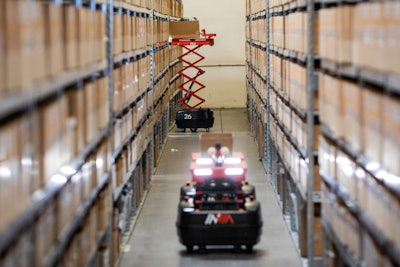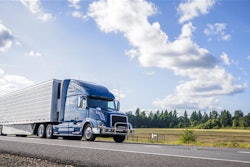
Digitalizing the supply chain is the future. But, getting there takes automation and emerging technology. It requires investing in solutions designed to track and trace, produce data analytics and deliver real-time alerts when parts of the supply chain fall off track. It requires buy-in from all decision-makers to help build the supply chain of tomorrow.
And, it’s this automation and emerging technology that helps the cold food chain build the supply chain of tomorrow.
In Food Logistics’ March/April 2022 issue, editor-in-chief Marina Mayer talks with several industry experts about warehouse automation and how automation and emerging technology future-proof supply chains.
Here’s an interview with Lior Elazary, CEO and co-founder, inVia Robotics, who explains how warehouses have had to implement automation in order to keep up with the e-commerce boom, with excerpts publishing in Food Logistics’ March/April 2022 issue. [CLICK HERE to read the article in full].
Food Logistics: From your perspective, what are some of the top challenges today’s cold food chains face?
Lior Elazary: Intelligent inventory management is one of the challenges - and opportunities - in cold food chains today. It’s particularly important in online grocery ordering. Just like with standard eCommerce supply chains, fulfillment has to be organized around random access. Whereas store fulfillment entails replenishing supplies of SKUs in bulk pallets and cases, direct-to-consumer delivery means each order is made up of multiple unique SKUs in “onesies and twosies” quantities. And online ordering for groceries is one of the categories that has grown the fastest since COVID. In 2021, nearly 49% of consumers were purchasing groceries online in some capacity.
In addition to random inventory access, it’s also important to have some sort of lot control in place that ensures your oldest product goes out first. This mitigates spoilage and waste, and extends the amount of time consumers can use products.
Food Logistics: How can warehouse automation help overcome these challenges?
Elazary: Automation technology available today for e-commerce fulfillment uses complex algorithms to enable random access inventory management. It identifies the quickest routes to take across a warehouse to pull random SKUs. Intelligence is also used to store SKUs based on “hit rates.” In other words, products that are ordered more frequently are situated closer to pack out. Products that are often ordered together may also be stored close to each other. This is where digitizing warehouses is making a major impact, and data is being used to make efficiency improvements.
Intelligence is also used to manage which inventory batches are pulled first. This is particularly important in cold storage where expiration dates are a factor. Today’s fulfillment optimization software can implement serialization and lot numbers to manage procedures like first in, first out (FIFO).
Our inVia Logic software includes both of these features. In fact, our inVia SmartPath pick path algorithms are patented. We apply them in directing our inVia Picker mobile robots to retrieve goods, or we also have a tool that directs people to take these same efficient paths where robots aren’t being used. When robots are used our customers see 4-5 times improvements in productivity, and they can see 2-3 times improvement by just deploying the software to guide their people. This productivity translates directly into faster cycle times, so ordered goods move more quickly through the fulfillment process. With perishable goods, every second saved in the warehouse means more time for consumers to keep them for use at home.
Food Logistics: The warehouse automation market is expected to grow to $27 billion by 2025; twice the size it was roughly five years ago, according to Research and Markets. To what do you attribute this growth to?
Elazary: In the last five years, and more specifically stemming from the COVID-19 pandemic, we saw a massive e-commerce boom. Whereas many businesses sold only or primarily through retail stores, many were forced to shift to online sales. Coupled with a national labor shortage, this posed a more dire situation for many warehouses that were already in need of ways to create efficiencies.
Pre-pandemic consumers were the warehouse workers. We would go to a store and pick all the items off the shelves that we wanted. We were the ones walking through store aisles of inventory, grabbing toilet paper, trash bags and a toothbrush. We were the ones taking these items off the shelves and delivering them back to our homes. Now warehouse workers have to do this for us. Orders come in throughout the day including random SKUs at varying quantities and they have to fulfill them with a quick turnaround time. Warehouses have to add automation to keep up with this crushing demand and unavailable labor.
Food Logistics: There are many different types of automated warehousing solutions. What kinds of emerging warehouse automation technologies do you see continuing to make an impact on the industry?
Elazary: There are many warehouse automation technologies available now, and the ones that will make the biggest impact are the ones that are adopted and adapted for widespread commercial use. That’s going to require market education. Those of us who have built these technologies have to help businesses understand the options available to them and how to match the right ones with their unique needs and operations.
Because of new business models where robotics is offered as a service (RaaS), businesses don’t need to become or hire robotics experts to bring automation into their warehouse. Vendors will run and maintain those systems for them. They do have to become familiar with how technology is being offered and how they integrate it within their organizations, both operationally and culturally. Some of this includes “knowing thyself” and understanding if they want to make a big, all-at-once change or if they want to adopt technology incrementally over a longer period of time. Vendors have to meet them there and help them understand the impacts of bringing in automation.
Food Logistics: What advice do you have for those companies still struggling to adopt warehouse automation? Where do you envision the hang-ups being and why?
Elazary: My advice would be to make a data-informed assessment of your current operation. Understand where you are today with picking rates, accuracy rates and labor costs. Look at your growth trajectory, and then see where your gaps are between the two. You may see that you need double productivity, or you may find that you need to increase productivity dramatically in order to meet your goals. For businesses that want to start by using their existing workforce and increasing their efficiency, they can start with using wearable technology. This alone can streamline processes and enable the intelligent use of data, guiding workers to pick and replenish items more efficiently.
Many businesses are ready to go straight to automation to take advantage of more dramatic increases in productivity. It’s also easier now to implement this type of technology with the advent of mobile robots. A common hurdle for businesses has traditionally been the implementation process because of cost and the time it takes to build the system. Traditional automation systems cost millions of dollars and generally take one to two years to construct and implement. On top of that, they take a very long time to deliver any return on investment, and in some cases never do.
With inVia, we have created a subscription-based, mobile robot approach to automation where our customers pay based on the productivity our robots deliver. We operate our customer’s systems for them remotely through our Robotics Operation Center (ROC), handling ongoing maintenance and troubleshooting. This removes the need for hiring in-house robotics expertise. We also work with our customers’ existing infrastructure to create inVia PickerWall, which allows employees to work in bursts throughout the day, leaving the robots to perform all rote tasks without interruption.
[CLICK HERE to read the article in full].




















